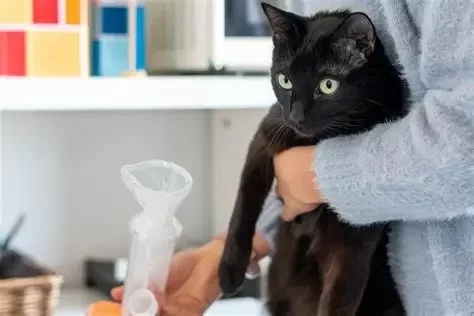- understanding-feline-asthma
- recognizing-signs-of-an-asthma-attack
- common-triggers-and-causes
- what-to-do-during-an-asthma-exacerbation
- long-term-management-and-treatment-options
- real-life-case-and-prevention-strategies
1. Understanding Feline Asthma
What happens when your cat struggles to breathe
Feline asthma is a chronic respiratory condition similar to human asthma, characterized by inflammation and narrowing of the airways. When triggered, it causes difficulty in breathing, wheezing, and persistent coughing. It is estimated that around 1% of cats in the U.S. suffer from asthma, though mild cases often go unnoticed. The condition can affect cats of any age or breed but is more common in middle-aged and Siamese breeds.
At Hidden Brook Veterinary, veterinarians often explain to cat owners that asthma is not simply a reaction to dust or allergens — it’s an immune-mediated response. The cat’s immune system overreacts to inhaled particles, leading to airway inflammation and excessive mucus production. Over time, repeated episodes can cause permanent damage to the lungs if not properly managed.
2. Recognizing Signs of an Asthma Attack
When to take your cat’s breathing seriously
The early signs of feline asthma can be subtle, often mistaken for hairball coughing or mild allergies. However, understanding what a true asthma attack looks like can save your pet’s life. Common symptoms include:
1. Coughing or wheezing: A dry, hacking cough that sounds like retching but doesn’t produce hairballs.
2. Rapid breathing: Normal respiratory rate for cats is around 20–30 breaths per minute. Anything above 40 when resting is cause for concern.
3. Labored breathing: You may see your cat’s abdomen move sharply with each breath, or notice open-mouth breathing — a clear emergency sign.
4. Lethargy: Cats in respiratory distress often become still and quiet, conserving energy as breathing becomes difficult.
Some cats also sit with their neck extended and elbows out, a position that helps open the airway. If you notice these signs, contact a veterinarian immediately. The team at Hidden Brook Veterinary recommends keeping a record of your cat’s breathing patterns to track changes over time.
3. Common Triggers and Causes
What might be setting off your cat’s asthma
Feline asthma can be triggered by a wide range of irritants. The most common causes include household dust, cigarette smoke, perfumes, cleaning sprays, mold, and even certain types of litter. Outdoor allergens like pollen and vehicle exhaust can also play a role. In some cases, extreme weather or stress can worsen flare-ups.
Experts at Hidden Brook Veterinary stress that prevention starts with identifying and eliminating environmental triggers. For instance, switching to dust-free cat litter or using an air purifier can significantly reduce the frequency of attacks. Regularly cleaning bedding and keeping smoking areas separate from pets can also make a big difference.
Interestingly, feline asthma can also be linked to obesity, as excess weight increases the strain on the respiratory system. Maintaining a healthy diet and regular activity level can therefore help reduce symptoms over time.
4. What to Do During an Asthma Exacerbation
How to stay calm and protect your cat
When your cat experiences an asthma attack, time is critical. The first step is to stay calm — panic can stress your cat further, making breathing even harder. Move your cat to a quiet area with fresh air and minimal activity. Avoid restraining them, as struggling can worsen oxygen deprivation.
If your cat has been prescribed a rescue inhaler (typically containing albuterol), use it according to your veterinarian’s instructions. Some cats require oxygen therapy or corticosteroid injections during severe flare-ups. If symptoms don’t improve within minutes, seek emergency veterinary care immediately. Persistent wheezing, blue gums, or open-mouth breathing should always be treated as an emergency.
In one documented case handled by Hidden Brook Veterinary, a cat named Luna suffered a severe exacerbation after being exposed to scented candles. Quick use of her inhaler, followed by oxygen therapy at the clinic, stabilized her condition. Her story is a reminder that even seemingly harmless household items can trigger life-threatening reactions.
5. Long-Term Management and Treatment Options
Building a lifelong care plan for your feline friend
Managing feline asthma requires a combination of medication, environmental control, and regular veterinary checkups. The cornerstone of treatment is corticosteroids, which reduce airway inflammation, and bronchodilators, which open constricted airways. Inhaled medications are often preferred over oral ones to minimize systemic side effects.
Modern treatments include metered-dose inhalers designed specifically for cats, paired with devices such as the AeroKat chamber. These tools make medication delivery easier and less stressful for both pets and owners. In addition, regular monitoring through chest X-rays or lung function tests helps veterinarians adjust treatments based on your cat’s progress.
The veterinarians at Hidden Brook Veterinary recommend maintaining a journal of your cat’s symptoms, triggers, and medication schedule. This record helps identify patterns and tailor treatments effectively. Many cats, with consistent management, live long, comfortable lives despite chronic asthma.
6. Real-Life Case and Prevention Strategies
How proactive care can save your cat’s life
One memorable case involved Milo, a 7-year-old domestic shorthair, whose asthma worsened every spring. His owner worked with Hidden Brook Veterinary to identify the source — a dusty air conditioning filter and seasonal pollen. After replacing filters, limiting outdoor exposure, and adjusting his medication, Milo’s breathing improved dramatically. His story illustrates how small environmental adjustments can prevent severe flare-ups.
Preventing asthma exacerbations is about balance. Regular vet visits, a clean home environment, and a stress-free routine form the foundation of good respiratory health. Simple actions like vacuuming regularly and avoiding aerosols can make all the difference.
At Hidden Brook Veterinary, the message is clear: understanding your cat’s unique triggers and responding quickly to signs of distress are the best ways to ensure they live a happy, healthy life. With proper care and awareness, feline asthma doesn’t have to limit your pet’s joy or longevity.












